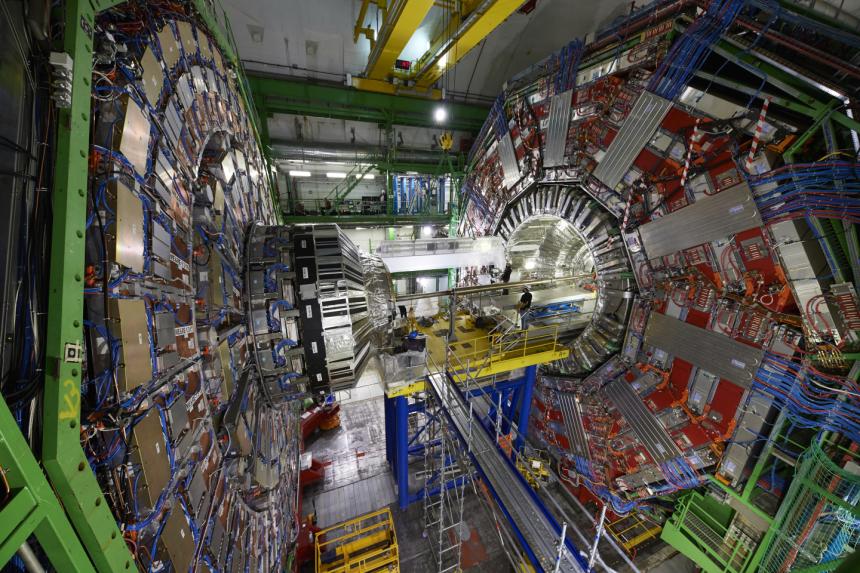GENEVA - Nuclear scientists are ready to smash new frontiers in quantum physics, and crack secrets hidden in so-called dark matter after a 3½-year upgrade of the particle accelerator Large Hadron Collider (LHC) on the France-Switzerland border.
The LHC is the world’s largest and most advanced particle collider, and took a decade to build, from 1998 to 2008.
It lets scientists test the theories of particle physics by allowing them to accelerate small particles – such as protons and ions – to extreme speeds, and smashing them together in an underground circular tunnel 27km long.
The LHC led to the discovery of the Higgs boson in 2012, a particle theorised to provide matter with mass. As a result, the theory’s developers, scientists Peter Higgs and Francois Englert, received the Nobel Prize in Physics in 2013.
Researchers from Cern, the European Organisation for Nuclear Research, are now ready for a couple of years of intense experimentation with the revamped LHC, which was shut down for its third upgrade at the end of 2018. The next upgrade is scheduled for 2026.
The recent upgrade saw two new detectors – the Faser and the Scattering and Neutrino – installed in the LHC.
These allow researchers to detect neutrinos, or subatomic particles, and look for a type of dark matter known as light dark matter in their experiments, said Professor Albert De Roeck, the Neutrino Physics Group leader at Cern.
Neutrinos – chargeless, ultra-light, subatomic particles – are extremely difficult to detect.
With scientists now being able to directly detect them in the LHC, they can analyse the characteristics of these largely unstudied particles.
Dark matter – thought to make up more than 85 per cent of the matter in the universe – has so far eluded scientists in their quest to track down its identity.
Traditional attempts to detect it involve waiting for collisions of dark matter with matter particles. Matter particles would recoil in such collisions, allowing scientists to detect dark matter particles.
These experiments have largely focused on heavy dark matter, as opposed to light dark matter.
Light dark matter particles, posited to have lighter masses than protons, would not be able to produce a large enough recoil for most experiments to detect them.
Instead of directly detecting dark matter, Cern researchers will try to produce light dark matter particles by creating them via collisions in the LHC, where the new detectors are specially engineered to detect them.
“We are in the phase of commissioning the detectors... It’s like a shirt which is wrinkled, and we are ironing out the problems we see, because we have hundreds of cables and many sensitive elements… We are hoping to get the first physics results by spring or by summer next year,” Prof De Roeck told The Straits Times in November.
Cern has also made sweeping engineering revamps to the LHC. It boosted the power of injectors and increased the sensitivity of other detectors.
The improved injectors, which accelerate particles before injecting them into the LHC, can generate larger energies.
This means protons can now collide at a total energy of 13.6 trillion electronvolts (TeV), smashing their previous global record of 13TeV. The additional 0.6TeV significantly increases the possibility of creating new particles due to the higher energy collisions.
The upgraded detectors allow for better tracking of the collisions which can now occur with greater intensity and frequency. The LHC also has a bigger data capacity with the upgrade.
Apart from searching for candidates of dark matter, scientists will also be able to investigate the properties of quark-gluon plasma (QGP), a special state of matter thought to have existed for only 10 microseconds after the start of the universe, in an event known as the Big Bang.
The higher collision energies in the LHC will allow scientists to investigate if QGP – currently observed to be a frictionless liquid – becomes gas-like at higher temperatures.
Researchers also plan to investigate if there is one or multiple types of Higgs boson.
They will also continue their investigations into the matter-antimatter symmetry in the universe, and look for evidence that violates the Standard Model, which is currently the best theory available to describe the most basic building blocks of the universe.
Outside of particle physics, Cern is reaching out to various sectors unrelated to research. For instance, it is collaborating with the medical industry to build hadron therapy centres in Europe. Hadron therapy is a safer alternative to current radiation technologies in treating cancer.
Cern plans to continue exploring domains such as electronics, manufacturing and many more.
It is also looking into quantum technologies and how they can play a role in its data-taking capabilities and infrastructure. Quantum technologies harness the laws of quantum mechanics to build computing infrastructure that is significantly more compact and faster than current computers.
“We just had a conference here about quantum computing, and how Cern could play a role in contributing with big stakeholders like (computing giant) IBM,” said Prof De Roeck.


